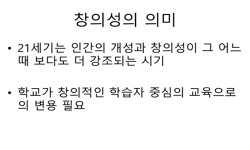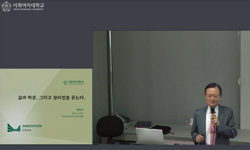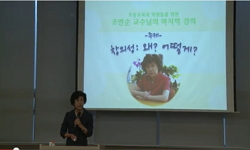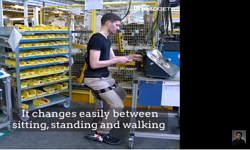This study introduces an alternative way to assess and identify creative young children through the teacher observation in classroom, Nebraska Starry Night Observation Protocol(NSNO). The NSNO, developmentally-appropriate and observation-based scale, ...
http://chineseinput.net/에서 pinyin(병음)방식으로 중국어를 변환할 수 있습니다.
변환된 중국어를 복사하여 사용하시면 됩니다.
- 中文 을 입력하시려면 zhongwen을 입력하시고 space를누르시면됩니다.
- 北京 을 입력하시려면 beijing을 입력하시고 space를 누르시면 됩니다.

교사 관찰에 의한 창의적 유아의 판별의 가능성 탐색 = Finding Creative Young Children Through the Teacher Observation in Classroom
한글로보기https://www.riss.kr/link?id=A82535063
- 저자
- 발행기관
- 학술지명
- 권호사항
-
발행연도
2010
-
작성언어
-
- 주제어
-
KDC
300
-
등재정보
KCI등재
-
자료형태
학술저널
- 발행기관 URL
-
수록면
21-45(25쪽)
-
KCI 피인용횟수
3
- 제공처
-
0
상세조회 -
0
다운로드
부가정보
다국어 초록 (Multilingual Abstract)
This study introduces an alternative way to assess and identify creative young children through the teacher observation in classroom, Nebraska Starry Night Observation Protocol(NSNO). The NSNO, developmentally-appropriate and observation-based scale, provides nominal descriptions of 17 key qualities or behaviors found repeatedly in the literature on characteristics of able and creative children. Based on the numbers and areas of 17 behaviors observed by teachers, the child`s strength and level of creativity is decided. Using the NSNO, children are more likely to be truly assessed and not just identified. Specific explanation about the NSNO in both contents and methods is discussed in depth in the study. For the study 110 children who belong to the 4 classrooms in 2 kindergartens participated, and they were observed by one classroom teacher and two observers in each classroom. The inter-rater reliability among the teachers and the observers was .90. Two cases of creative children who were identified in the study were examined in depth to explain how the NSNO can be used and interpreted in real situations. The implication of the study was discussed related to the identification of creative young children.
참고문헌 (Reference)
1 임선하, "창의성에의 초대" 교보문고 1995
2 김판희, "유아의 창의성에 관한 연구의 최근동향" 10 (10): 105-122, 2001
3 최인수, "유아의 창의성 측정도구에 관한 고찰" 20 (20): 139-166, 2000
4 노영희, "교사용 유아 창의성 평정척도 개발" 한국열린유아교육학회 11 (11): 23-44, 2006
5 한기순, "교사 관찰에 의한 창의적 유아 판별도구의 타당성 분석" 한국열린유아교육학회 15 (15): 1-22, 2010
6 Roedell, W. C., "young children" Columbia University, Teachers College Press 1980
7 Renzulli, J. S., "What makes giftedness? Re-examining a definition" 60 : 180-184, 1978
8 Passow, A. H., "Toward improving identification of talent potential among minority and disadvantaged students" 18 : 198-202, 1996
9 Renzulli, J., "The three-ring conception of giftedness: Its implications for understanding the nature of innovation. in : The international handbook on innovation" Pergamon 79-96, 2003
10 Amabile, T. M., "The social psychology of creativity: A componential conceptualization" 45 (45): 357-376, 1983
1 임선하, "창의성에의 초대" 교보문고 1995
2 김판희, "유아의 창의성에 관한 연구의 최근동향" 10 (10): 105-122, 2001
3 최인수, "유아의 창의성 측정도구에 관한 고찰" 20 (20): 139-166, 2000
4 노영희, "교사용 유아 창의성 평정척도 개발" 한국열린유아교육학회 11 (11): 23-44, 2006
5 한기순, "교사 관찰에 의한 창의적 유아 판별도구의 타당성 분석" 한국열린유아교육학회 15 (15): 1-22, 2010
6 Roedell, W. C., "young children" Columbia University, Teachers College Press 1980
7 Renzulli, J. S., "What makes giftedness? Re-examining a definition" 60 : 180-184, 1978
8 Passow, A. H., "Toward improving identification of talent potential among minority and disadvantaged students" 18 : 198-202, 1996
9 Renzulli, J., "The three-ring conception of giftedness: Its implications for understanding the nature of innovation. in : The international handbook on innovation" Pergamon 79-96, 2003
10 Amabile, T. M., "The social psychology of creativity: A componential conceptualization" 45 (45): 357-376, 1983
11 Ford, D. Y., "The recruitment and retention of African-American students in gifted education programs: Implications and recommendations" University of Connecticut, The National Research Center on the Gifted and Talented 1994
12 Ford, D. Y., "The elusive definition of creativity" 26 (26): 186-198, 1992
13 Bredekamp, S., "Reaching potentials: Appropriate curriculum and assessment for young children" National Association for the Education of Young Children (NAEYC) 1992
14 Barron, F, "Putting creativity to work. in : The nature of creativity" Cambridge University Press 76-98, 1988
15 Gardner. H., "Project Spectrum: Preschool Assessment Handbook" Teachers College Press 1998
16 Silverman, L. K., "Parenting young gifted children. in : Intellectual giftedness in young children" Haworth Press 73-87, 1986
17 Robinson, K., "Out of our minds: Learning to be creative" Capstone 2001
18 Griffin, N. S., "Nebraska project-Replication guide" University of Nebraska-Lincoln 1993
19 Griffin, N. S., "Nebraska Starry Night: A behavior-based observation protocol, version 8.893" University of Nebraska- Lincoln 1993
20 Hocevar, D., "Measurement of creativity: Review and critique" 45 (45): 450-464, 1981
21 Sternberg, R. J., "Lies we live by: Misapplication of tests in identifying the gifted" 26 (26): 157-161, 1982
22 Bredekamp, S., "Developmentally appropriate practice in early childhood programs serving children birth through age 8" NAEYC 1987
23 Sternberg, R. J., "Defying the crowd" The Free Press 1995
24 Amabile, T. M., "Creativity in context" West view Press 1996
25 Hunsaker, S. L., "Creativity and giftedness: Published instrument uses and abuses" 39 (39): 110-114, 1995
26 Baer, J., "Creativity and divergent thinking: A task-specific approach" Lawrence Erlbaum Associates 1993
27 Houtz, J. C., "Contribution of teacher ratings of behavioral characteristics to the prediction of divergent thinking and problem solving" 19 : 380-383, 1982
28 Griffin, N. S., "Content validity and field-test results of Nebraska Starry Night Observation Protocol" University of Nebraska- Lincoln 1995
29 Sternberg, R. J., "Conceptions of giftedness" Cambridge University Press 1986
30 Houtz, J. C., "Assessment of creativity: Resolving a mid-life crisis" 7 (7): 269-301, 1995
31 Han, K. S., "A classroom-based observation approach" 28 (28): 1-16, 2003
동일학술지(권/호) 다른 논문
-
다문화가정 어머니의 양육스트레스, 양육효능감이 양육행동에 미치는 영향
- 미래유아교육학회
- 이선미 ( Sun Mi Lee )
- 2010
- KCI등재
-
TV 안보기-책읽기 활동이 유아의 읽기 태도와 가정의 읽기환경에 미치는 영향
- 미래유아교육학회
- 이민정 ( Min Jung Lee )
- 2010
- KCI등재
-
유아교육기관을 위한 통합교육 컨설테이션 모형 개발에 관한 연구
- 미래유아교육학회
- 최애경 ( Ae Kyung Choi )
- 2010
- KCI등재
-
- 미래유아교육학회
- 김순환 ( Soon Hwan Kim )
- 2010
- KCI등재
분석정보
인용정보 인용지수 설명보기
학술지 이력
| 연월일 | 이력구분 | 이력상세 | 등재구분 |
|---|---|---|---|
| 2026 | 평가예정 | 재인증평가 신청대상 (재인증) | |
| 2020-04-14 | 학회명변경 | 영문명 : 미등록 -> Association for Future Early Childhood Education |  |
| 2020-01-01 | 평가 | 등재학술지 유지 (재인증) |  |
| 2017-01-01 | 평가 | 등재학술지 유지 (계속평가) |  |
| 2013-01-01 | 평가 | 등재학술지 유지 (등재유지) |  |
| 2010-01-01 | 평가 | 등재학술지 유지 (등재유지) |  |
| 2008-01-01 | 평가 | 등재학술지 유지 (등재유지) |  |
| 2005-01-01 | 평가 | 등재학술지 선정 (등재후보2차) |  |
| 2004-01-01 | 평가 | 등재후보 1차 PASS (등재후보1차) |  |
| 2002-01-01 | 평가 | 등재후보학술지 선정 (신규평가) |  |
학술지 인용정보
| 기준연도 | WOS-KCI 통합IF(2년) | KCIF(2년) | KCIF(3년) |
|---|---|---|---|
| 2016 | 2.26 | 2.26 | 2.22 |
| KCIF(4년) | KCIF(5년) | 중심성지수(3년) | 즉시성지수 |
| 2.16 | 2.22 | 2.445 | 0.45 |





 KISS
KISS






